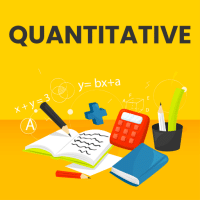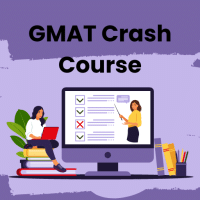GMAT Exam > GMAT Questions > A random 10-letter code is to be formed using...
Start Learning for Free
A random 10-letter code is to be formed using the letters A, B, C, D, E, F, G, H, I and I (only the “I” will be used twice). What is the probability that a code that has the two I’s adjacent to one another will be formed?
- a)1/10
- b)1/8
- c)1/5
- d)1/4
- e)1/2
Correct answer is option 'C'. Can you explain this answer?
| FREE This question is part of | Download PDF Attempt this Test |
Verified Answer
A random 10-letter code is to be formed using the letters A, B, C, D, ...
To find the probability of forming a code with two adjacent I’s, we must find the total number of such codes and divide by the total number of possible 10-letter codes. The total number of possible 10-letter codes is equal to the total number of anagrams that can be formed using the letters ABCDEFGHII, that is 10!/2! (we divide by 2! to account for repetition of the I's).
To find the total number of 10 letter codes with two adjacent I’s, we can consider the two I’s as ONE LETTER. The reason for this is that for any given code with adjacent I’s, wherever one I is positioned, the other one must be positioned immediately next to it. For all intents and purposes, we can think of the 10 letter codes as having 9 letters (I-I is one). There are 9! ways to position 9 letters.
Probability = (# of adjacent I codes) / (# of total possible codes) = 9! ÷ (10! / 2! ) = ( 9!2! / 10! ) = (9!2! / 10(9!) ) = 1/5
To find the total number of 10 letter codes with two adjacent I’s, we can consider the two I’s as ONE LETTER. The reason for this is that for any given code with adjacent I’s, wherever one I is positioned, the other one must be positioned immediately next to it. For all intents and purposes, we can think of the 10 letter codes as having 9 letters (I-I is one). There are 9! ways to position 9 letters.
Probability = (# of adjacent I codes) / (# of total possible codes) = 9! ÷ (10! / 2! ) = ( 9!2! / 10! ) = (9!2! / 10(9!) ) = 1/5
Most Upvoted Answer
A random 10-letter code is to be formed using the letters A, B, C, D, ...
Letters I are repeated). How many different codes can be formed if the first and last letters must be vowels?
To solve this problem, we can break it down into two parts:
1. Counting the number of ways to arrange the vowels (A, E, I, I) in the first and last positions.
2. Counting the number of ways to arrange the remaining 8 letters (B, C, D, F, G, H, I, I) in the remaining 8 positions.
1. Counting the number of ways to arrange the vowels (A, E, I, I) in the first and last positions:
Since there are 2 I's and 1 each of A and E, we can use the formula for permutations of objects with repetition: (n!) / (r1! * r2! * ... * rk!), where n is the total number of objects and r1, r2, ..., rk are the repetitions of each object.
In this case, the number of ways to arrange the vowels is (4!) / (2! * 1! * 1!) = 12.
2. Counting the number of ways to arrange the remaining 8 letters (B, C, D, F, G, H, I, I) in the remaining 8 positions:
Since all the remaining letters are distinct, we can simply use the formula for permutations: n!
In this case, the number of ways to arrange the remaining letters is 8!.
To find the total number of different codes, we multiply the number of ways to arrange the vowels by the number of ways to arrange the remaining letters:
Total number of codes = 12 * 8! = 12 * 40,320 = 483,840
Therefore, there are 483,840 different codes that can be formed if the first and last letters must be vowels.
To solve this problem, we can break it down into two parts:
1. Counting the number of ways to arrange the vowels (A, E, I, I) in the first and last positions.
2. Counting the number of ways to arrange the remaining 8 letters (B, C, D, F, G, H, I, I) in the remaining 8 positions.
1. Counting the number of ways to arrange the vowels (A, E, I, I) in the first and last positions:
Since there are 2 I's and 1 each of A and E, we can use the formula for permutations of objects with repetition: (n!) / (r1! * r2! * ... * rk!), where n is the total number of objects and r1, r2, ..., rk are the repetitions of each object.
In this case, the number of ways to arrange the vowels is (4!) / (2! * 1! * 1!) = 12.
2. Counting the number of ways to arrange the remaining 8 letters (B, C, D, F, G, H, I, I) in the remaining 8 positions:
Since all the remaining letters are distinct, we can simply use the formula for permutations: n!
In this case, the number of ways to arrange the remaining letters is 8!.
To find the total number of different codes, we multiply the number of ways to arrange the vowels by the number of ways to arrange the remaining letters:
Total number of codes = 12 * 8! = 12 * 40,320 = 483,840
Therefore, there are 483,840 different codes that can be formed if the first and last letters must be vowels.
Attention GMAT Students!
To make sure you are not studying endlessly, EduRev has designed GMAT study material, with Structured Courses, Videos, & Test Series. Plus get personalized analysis, doubt solving and improvement plans to achieve a great score in GMAT.

|
Explore Courses for GMAT exam
|

|
Similar GMAT Doubts
A random 10-letter code is to be formed using the letters A, B, C, D, E, F, G, H, I and I (only the “I” will be used twice). What is the probability that a code that has the two I’s adjacent to one another will be formed?a)1/10b)1/8c)1/5d)1/4e)1/2Correct answer is option 'C'. Can you explain this answer?
Question Description
A random 10-letter code is to be formed using the letters A, B, C, D, E, F, G, H, I and I (only the “I” will be used twice). What is the probability that a code that has the two I’s adjacent to one another will be formed?a)1/10b)1/8c)1/5d)1/4e)1/2Correct answer is option 'C'. Can you explain this answer? for GMAT 2024 is part of GMAT preparation. The Question and answers have been prepared according to the GMAT exam syllabus. Information about A random 10-letter code is to be formed using the letters A, B, C, D, E, F, G, H, I and I (only the “I” will be used twice). What is the probability that a code that has the two I’s adjacent to one another will be formed?a)1/10b)1/8c)1/5d)1/4e)1/2Correct answer is option 'C'. Can you explain this answer? covers all topics & solutions for GMAT 2024 Exam. Find important definitions, questions, meanings, examples, exercises and tests below for A random 10-letter code is to be formed using the letters A, B, C, D, E, F, G, H, I and I (only the “I” will be used twice). What is the probability that a code that has the two I’s adjacent to one another will be formed?a)1/10b)1/8c)1/5d)1/4e)1/2Correct answer is option 'C'. Can you explain this answer?.
A random 10-letter code is to be formed using the letters A, B, C, D, E, F, G, H, I and I (only the “I” will be used twice). What is the probability that a code that has the two I’s adjacent to one another will be formed?a)1/10b)1/8c)1/5d)1/4e)1/2Correct answer is option 'C'. Can you explain this answer? for GMAT 2024 is part of GMAT preparation. The Question and answers have been prepared according to the GMAT exam syllabus. Information about A random 10-letter code is to be formed using the letters A, B, C, D, E, F, G, H, I and I (only the “I” will be used twice). What is the probability that a code that has the two I’s adjacent to one another will be formed?a)1/10b)1/8c)1/5d)1/4e)1/2Correct answer is option 'C'. Can you explain this answer? covers all topics & solutions for GMAT 2024 Exam. Find important definitions, questions, meanings, examples, exercises and tests below for A random 10-letter code is to be formed using the letters A, B, C, D, E, F, G, H, I and I (only the “I” will be used twice). What is the probability that a code that has the two I’s adjacent to one another will be formed?a)1/10b)1/8c)1/5d)1/4e)1/2Correct answer is option 'C'. Can you explain this answer?.
Solutions for A random 10-letter code is to be formed using the letters A, B, C, D, E, F, G, H, I and I (only the “I” will be used twice). What is the probability that a code that has the two I’s adjacent to one another will be formed?a)1/10b)1/8c)1/5d)1/4e)1/2Correct answer is option 'C'. Can you explain this answer? in English & in Hindi are available as part of our courses for GMAT.
Download more important topics, notes, lectures and mock test series for GMAT Exam by signing up for free.
Here you can find the meaning of A random 10-letter code is to be formed using the letters A, B, C, D, E, F, G, H, I and I (only the “I” will be used twice). What is the probability that a code that has the two I’s adjacent to one another will be formed?a)1/10b)1/8c)1/5d)1/4e)1/2Correct answer is option 'C'. Can you explain this answer? defined & explained in the simplest way possible. Besides giving the explanation of
A random 10-letter code is to be formed using the letters A, B, C, D, E, F, G, H, I and I (only the “I” will be used twice). What is the probability that a code that has the two I’s adjacent to one another will be formed?a)1/10b)1/8c)1/5d)1/4e)1/2Correct answer is option 'C'. Can you explain this answer?, a detailed solution for A random 10-letter code is to be formed using the letters A, B, C, D, E, F, G, H, I and I (only the “I” will be used twice). What is the probability that a code that has the two I’s adjacent to one another will be formed?a)1/10b)1/8c)1/5d)1/4e)1/2Correct answer is option 'C'. Can you explain this answer? has been provided alongside types of A random 10-letter code is to be formed using the letters A, B, C, D, E, F, G, H, I and I (only the “I” will be used twice). What is the probability that a code that has the two I’s adjacent to one another will be formed?a)1/10b)1/8c)1/5d)1/4e)1/2Correct answer is option 'C'. Can you explain this answer? theory, EduRev gives you an
ample number of questions to practice A random 10-letter code is to be formed using the letters A, B, C, D, E, F, G, H, I and I (only the “I” will be used twice). What is the probability that a code that has the two I’s adjacent to one another will be formed?a)1/10b)1/8c)1/5d)1/4e)1/2Correct answer is option 'C'. Can you explain this answer? tests, examples and also practice GMAT tests.

|
Explore Courses for GMAT exam
|

|
Suggested Free Tests
Signup for Free!
Signup to see your scores go up within 7 days! Learn & Practice with 1000+ FREE Notes, Videos & Tests.
























